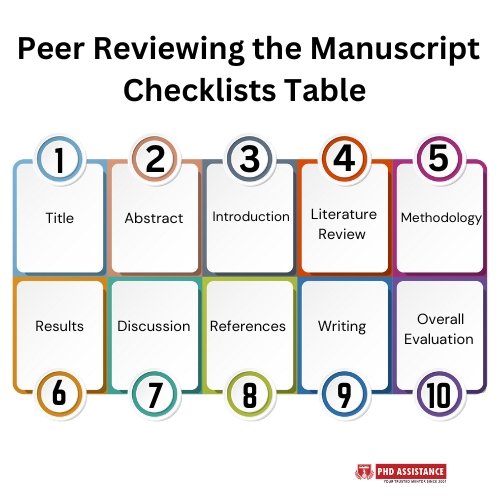Peer Reviewing the Manuscript Checklists Table
Peer Review is defined as “the process of subjecting an author’s scholarly work, research, or ideas to the scrutiny of others who are experts in the same field.” Peer review is designed to fulfil two key functions. For starters, it functions as a filter to guarantee that only high-quality research is published, particularly in recognized journals, by analyzing the study’s validity, importance, and originality. Second, peer review is designed to enhance the quality of articles that are judged eligible for publication. Peer reviewers advise writers on how to enhance the quality of their manuscripts and identify any problems that need to be corrected before publication.
Introduction
Writing a peer review is an organized process, but it’s simple if you follow a few basic steps. Writing a well-structured peer review can aid in preserving the quality and integrity of research in your field. Peer review, according to PhD Assistance, “teaches you how to review a manuscript, spot common flaws in research papers, and improve your own chances of being a successful published author.” The checklist stages for drafting an excellent peer review are listed below.

Here is a checklist table for peer-reviewing a manuscript:
| Aspect to Review | Checkpoints |
| Title | Does the title accurately reflect the content of the manuscript? Is the title clear and concise? |
| Abstract | Does the abstract summarize the manuscript effectively? Does it provide a clear overview of the research question, methods, results, and conclusions? |
| Introduction | Does the introduction provide adequate background information and context for the research question? Is the research question clearly stated? |
| Literature Review | Is the literature review comprehensive and up-to-date? Does it provide sufficient background information and context for the research question? |
| Methodology | Are the methods clearly described and replicable? Are there any potential issues or limitations with the methodology that needs to be addressed? |
| Results | Are the results presented clearly and logically? Does appropriate statistical analysis support them? |
| Discussion | Do the results support the conclusions? Are the implications of the research clearly stated? Are there any limitations or potential issues that need to be addressed? |
| References | Are all references cited in the text included in the reference list? Are the references up-to-date and from reputable sources? |
| Writing | Is the manuscript well-written, clear, and concise? Are there any grammatical or spelling errors? |
| Overall Evaluation | Does the manuscript make a significant contribution to the field? Are there any major issues or concerns that must be addressed before publication? |
These are just some checkpoints to consider when peer-reviewing a manuscript. The specific checkpoints may vary depending on the journal or publisher’s peer-review guidelines.
PhD Assistance
PhD Assistance professionals are dedicated to offering superior paper peer review service in accordance with your specifications. We examine the items from your point of view and explain how you’re them—being compassionate while remaining truthful. Our specialists’ access to all essential sources and their knowledge of the requirement for journal manuscripts make it worthwhile to seek their assistance.
References
Kelly J, Sadeghieh T, Adeli K. Peer Review in Scientific Publications: Benefits, Critiques, & A Survival Guide. EJIFCC. 2014 Oct 24;25(3):227-43. PMID: 27683470; PMCID: PMC4975196.
 Previous Post
Previous Post Next Post
Next Post
